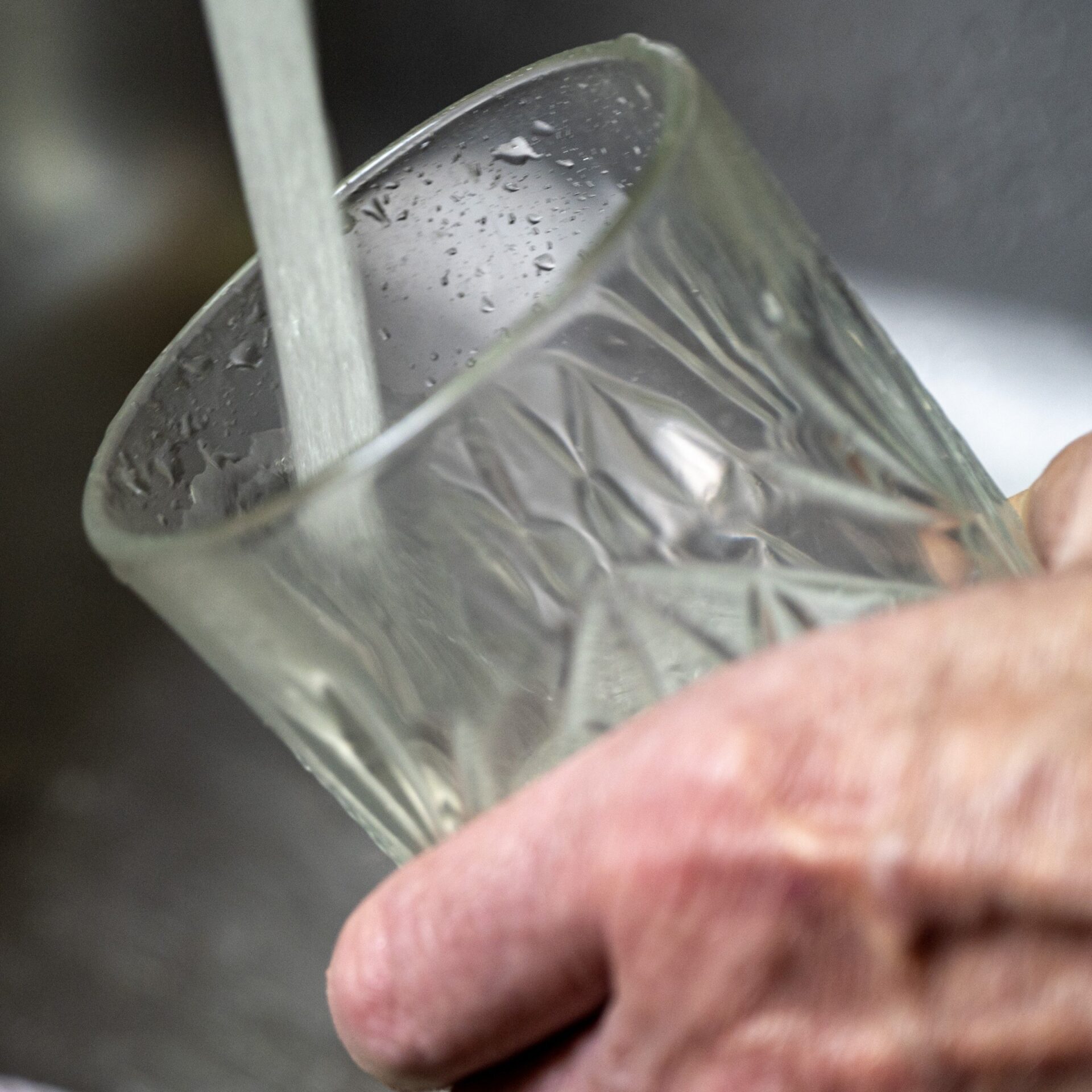
Monmouth resident John Hale fills a glass with water from the well at his house in North Monmouth. He worried about PFAS contamination in his well water because others with property near the mill have experienced high levels of “forever chemicals” in their wells. Tests found no contamination in his well. Joe Phelan/Kennebec Journal
About 500 Maine households rely on well water that is considered too contaminated to drink under new federal limits on forever chemicals – but not contaminated enough to qualify for state money to install the expensive filtration system needed to make it potable.
And those are only the private wells that have been tested by the state. No one knows how many others there are that fall into the gray area between state and federal safety standards and have yet to be tested or aren’t located near a farm that used tainted sludge to fertilize its fields.
They exist in a forever chemical limbo, created by conflicting regulatory standards and anxiety over the rising costs of taming Maine’s forever chemical problem. Maine didn’t make the toxic chemicals, but its environmental leaders concede that its now-defunct sludge recycling program made the problem worse.
The state is halfway through a four-year investigation of 1,100 fields where farmers used state-licensed sewage sludge as a fertilizer, unaware the semisolid byproduct of wastewater treatment plants was full of forever chemicals. It has spent $15 million so far to help 484 landowners hurt by its sludge recycling.
That help came in the form of bottled water, payments to cover the cost of tying into a municipal water system, and state-funded installation and maintenance of 360 filter systems. Depending on site details and contamination levels, filters can cost as little as $3,400 or as much as $15,900.
But officials say Maine doesn’t have enough money to help everybody its sludge recycling program hurt, and that private landowners who draw water from a well that tests below the current state standard but above the federal one are on their own. At least for now.
“We’re worried that we’re not going to have enough money to keep treating the ones we’ve already done,” said Melanie Loyzim, the commissioner of the Department of Environmental Protection, referring to the cost of maintaining the state-installed wells. “We’ve got to go for the higher concentrations.”
In all, Maine has dedicated more than $100 million to address forever chemicals over the last few years.
The DEP will update state lawmakers on the status of its sludge investigation in January, Loyzim said. By then, state officials should have completed sampling another 400 sites, leaving an estimated 500 to go. At that time, DEP will lay out investigation costs and ask for guidance on how to use its remaining funds.
It’s unlikely the state will be able to continue maintaining the 360 filters it has already installed without an infusion of new cash, Loyzim said. The average cost of testing, cleaning and disposing of old filters is $5,300 a year. Based on that average, the state is spending $1.9 million a year on existing filter systems.
Residents of hard-hit areas like Fairfield are particularly worried about the state running out of money. Fairfield has the most contaminated wells (205) and state-installed filter systems of any Maine town or city. Some Fairfield residents with filter systems report annual maintenance costs as high as $12,000.
At this point, Maine has no plan to resample wells deemed unsafe by new federal standards or to even tell the property owners that their situation has changed. It will be up to them to realize that the same tests that once told them their water was safe to drink now tell a much more dangerous story.
“The DEP has not specifically notified homeowners that their results fall between,” said Dave Madore, a departmental spokesman who also serves as deputy commissioner. “However, each homeowner tested is in receipt of their laboratory reports showing all the data.”
Environmental advocates find the lack of direct notifications even more troubling than Maine’s decision not to fund the in-betweener remediation. Notification would at least allow affluent homeowners to self-fund a remediation effort, said policy analyst Jared Hayes of the Environmental Working Group.
“Without notification, people aren’t able to take action or make the choice for themselves,” Hayes said.
State officials say homeowners who participated in the state sludge investigation will stay informed of the latest PFAS news, but Sergio Cahueque, a community organizer for Defend Our Health, believes it’s more likely that a clean state test would cause homeowners to tune PFAS news out.
“Not all well water owners in Maine are following PFAS water standard issues as closely as we are,” Cahueque said. “After DEP tested wells and told homeowners that their water was below the standard and safe to consume, some people probably stopped worrying or questioning the quality of their well water.”
Per- and polyfluoroalkyl substances, or PFAS, are used to make thousands of common household and industrial products resistant to heat, water and grease. Because they can linger in the environment for decades, they are found almost everywhere: in pandas and polar bears, in the rain, even in our blood.
Even trace amounts of some PFAS are considered a public health risk, according to federal regulators. High exposure over a long time can cause cancer. Exposure during critical life stages, such as in early childhood, can also cause life-changing harm.
Until three years ago, state and federal regulators considered drinking water safe if it had less than 70 parts per trillion, or ppt, of certain harmful forever chemicals. Maine beefed up its standard in 2021 by dropping its PFAS limit to 20 ppt after high levels were found in a handful of Maine farms.
In April, after months of debate, the U.S. Environmental Protection Agency announced it had raised its PFAS standard, too, and had set a strict new limit of 4 ppt for PFOA and PFOS, two especially harmful ones, and 10 parts per trillion for three others, PFNA, PFHxS, and HFPO-DA.
The state’s sludge investigation, which began in November 2021, has uncovered 484 residential wells that tested above the state’s 20 ppt safety limit, plus another 500 that test below Maine’s limit but above the EPA’s new 4-4-10 ppt limit.
Maine plans to modify its state drinking water standard to match the new federal one, but officials say they will keep using the 20 ppt threshold to decide who gets financial assistance. Maine must prioritize its spending on projects that will help the most people and people who face the most exposure, officials say.
Maine doesn’t have to provide any financial assistance to help private landowners. A state law passed in 2012 requires community water supplies to comply with state drinking water standards, but it requires no compliance or even testing of the 70% of Mainers who rely on private wells for their drinking water.
The new federal rule doesn’t apply to private landowners either, which means that Maine isn’t breaking any rule by deciding to use a 20 ppt standard as a cutoff to decide which contaminated well owners get bottled water, a filter or a tie-in to a nearby municipal water system.
Community water suppliers have no choice but to comply with the new federal rule. These 44 systems – including 12 public schools, nine municipal water and sewer districts, four private schools, and a handful of nursing homes and day cares – have five years to find a way to come in below the federal limits.
Some of these better-funded in-betweeners are already well on their way to federal compliance.
Shapleigh Memorial School outside Waterboro was just 0.03 ppt over the federal limit, but that didn’t stop the rural school district from deciding to filter the water at that school and two others testing above the state drinking water threshold, said Colin Walsh, the district’s finance and operations director.
“Our expert consultant indicated that PFAS standards would likely be lowered,” Walsh said. “There’s a lot more efficiency to doing them all at once. … If all goes well, we’ll have new PFAS systems installed in two of the schools before classes start in September, and the third not too long after that.”
The state drinking water program is providing three $50,000 grants to help RSU 57 pay for the filters. Until then, the students and staff at all three schools are drinking bottled water, Walsh said.
The Sanford Water District is using a grant to study what to do about two “in-between” wells it uses to supply public water users. A rough estimate puts the capital cost of filtering PFAS from these two wells – which come in at 1.96 and 5.27 ppt above the federal limit – at $4 million to $8 million apiece.
Sanford is even investigating whether it can buy water from another utility, Superintendent David Parent said.
“We don’t have anything that looks like real contamination in Sanford,” Parent said. “They’re fairly low numbers, but we’re going to need to do something about every single one of them because that’s where the regulations are going. That’s what the public wants. But it’s going to cost us.”
Sanford is applying for state and federal grants to cover installation, testing and filtration costs, Parent said. He also hopes to collect up to $1 million from a class-action lawsuit filed by water districts against forever chemical makers such as 3M and Dupont.
Others, like Erskine Academy in South China, aren’t making any changes because additional tests have come back under the EPA limit.
Some, like Carolyn and George Siefert, who own Wooded Glen Trailer Park in Kenduskeag, are doing nothing in hopes the problem will fix itself.
“We’ll just do another test, I guess, and hope it’s better,” Carolyn said. “We certainly can’t afford to drill another well when we’d probably just get the same result. But we probably can’t afford to install a filter, either. They’re even more expensive. I don’t know what we’ll do.”
Siefert said she was told that Wooded Grove’s water was OK after its last test, Siefert said. She said that she didn’t even know another test had been done. She didn’t realize the park’s new status was caused by a beefed-up federal standard, not a change in water quality detected by a second test.
“We thought we were OK,” Siefert said. “Now you’re telling me we’re not? What happened?”
« Previous
Next »



Invalid username/password.
Please check your email to confirm and complete your registration.
Use the form below to reset your password. When you’ve submitted your account email, we will send an email with a reset code.